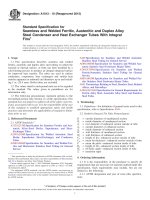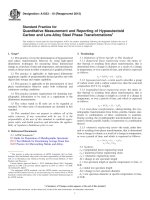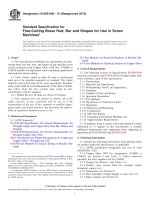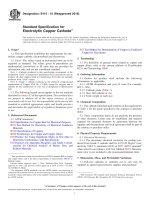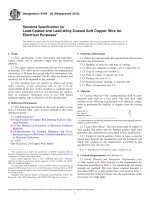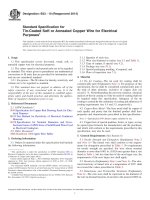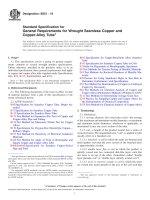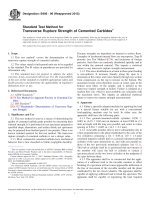Astm b 942 10 (2015)
Bạn đang xem bản rút gọn của tài liệu. Xem và tải ngay bản đầy đủ của tài liệu tại đây (229.56 KB, 9 trang )
Designation: B942 − 10 (Reapproved 2015)
Standard Guide for
Specification and Quality Assurance for the Electrical
Contact Performance of Crimped Wire Terminations1
This standard is issued under the fixed designation B942; the number immediately following the designation indicates the year of
original adoption or, in the case of revision, the year of last revision. A number in parentheses indicates the year of last reapproval. A
superscript epsilon (´) indicates an editorial change since the last revision or reapproval.
B542 Terminology Relating to Electrical Contacts and Their
Use
B827 Practice for Conducting Mixed Flowing Gas (MFG)
Environmental Tests
B845 Guide for Mixed Flowing Gas (MFG) Tests for Electrical Contacts
B868 Practice for Contact Performance Classification of
Electrical Connection Systems
B913 Test Method for Evaluation of Crimped Electrical
Connections to 16-Gauge and Smaller Diameter Stranded
and Solid Conductors
E122 Practice for Calculating Sample Size to Estimate, With
Specified Precision, the Average for a Characteristic of a
Lot or Process
2.2 Other References:3
UL 486-A Wire connectors and Soldering Lugs for Use With
Copper Conductors
UL-310 Electrical Quick-Connect Terminals
1. Scope
1.1 This guide contains practices for specifying and evaluating the electrical contact performance of crimped-type terminations with solid or stranded conductors.
1.2 This guide provides information relevant to the electrical contact performance of a crimped wire termination. It does
not cover other aspects of selection and use of crimped
terminals.
1.3 The methods discussed in this guide apply only to the
wire termination, which is the electrical contact interface
between the conductor(s) and the terminal. Other aspects
important to terminal evaluation, such as the properties and
performance of electrical insulation, the effectiveness of strain
relief features, and the quality of contact between the terminal
and other electrical circuit elements, are not included.
1.4 The values stated in SI units are to be regarded as
standard. No other units of measurement are included in this
standard.
1.5 This standard does not purport to address all of the
safety concerns, if any, associated with its use. It is the
responsibility of the user of this standard to become familiar
with all hazards including those identified in the appropriate
Safety Data Sheet (SDS) for this product/material as provided
by the manufacturer, to establish appropriate safety and health
practices, and determine the applicability of regulatory limitations prior to use.
3. Terminology
3.1 Many terms related to electrical contacts used in this
guide are defined in Terminology B542.
3.2 Definitions of Terms Specific to This Standard:
3.2.1 connection resistance, n—the electrical resistance attributable to a wire termination over and above that of an
identical solid metallic structure without pressure contact
interfaces. For crimped terminations that are the subject of this
guide, the connection resistance results from the resistance of
a multitude of contact regions having both film and constriction
resistance, plus, where stranded wire is involved, an additional
amount due to unequal current distribution among the wire
strands at the termination.
3.2.2 crimp, v—to establish an electrical and mechanical
attachment between the two members by mechanically deforming one contact member around another. In most cases, one
member is a stranded or solid wire, or a group of wires, the
other is a hollow cylinder or partial cylinder that is deformed
around the wire(s).
3.2.3 crimp barrel, crimp tab, n—the portion of the crimp
terminal that is deformed in the crimping operation.
2. Referenced Documents
2.1 ASTM Standards:2
B539 Test Methods for Measuring Resistance of Electrical
Connections (Static Contacts)
1
This guide is under the jurisdiction of ASTM Committee B02 on Nonferrous
Metals and Alloys and is the direct responsibility of Subcommittee B02.11 on
Electrical Contact Test Methods.
Current edition approved Oct. 1, 2015. Published October 2015. Originally
approved in 2005. Last previous edition approved in 2010 as B972 10ɛ1. DOI:
10.1520/B0942-10R15.
2
For referenced ASTM standards, visit the ASTM website, www.astm.org, or
contact ASTM Customer Service at For Annual Book of ASTM
Standards volume information, refer to the standard’s Document Summary page on
the ASTM website.
3
Available from Underwriters Laboratories Inc. (UL), .
Copyright © ASTM International, 100 Barr Harbor Drive, PO Box C700, West Conshohocken, PA 19428-2959. United States
1
B942 − 10 (2015)
tion failures in other applications have potentially severe
consequences, however, which may be avoided by use of
stringent acceptance criteria and quality control methods that
assure high quality connections.
3.2.4 crimped termination, n—a mechanical and electrical
connection between a conductor, generally a wire, and a
component, typically a terminal specifically made for the
purpose. The crimped termination is made by compressing
(crimping) the component (crimp barrel) or tab(s) of the
component around the conductor using a tool specifically
designed for the purpose.
3.2.5 crimp terminal, n—a metal component designed to be
electrically and mechanically attached to a wire by deforming
a portion of the component in a crimping operation to form an
attachment to the wire. The other end of the terminal usually
has a ring, fork, spade, tab, or related configuration designed to
attach to another circuit element. Some crimp terminals terminate multiple wires within the same crimp barrel.
5.4 A crimp termination is conceptually visualized as compressed into a virtually solid mass of metal, with wire and
terminal in intimate contact at the interfaces. Because of an
effect generally called “spring-back,” this is often incorrect.
Spring-back is the elastic recovery of the distorted metal back
towards its original shape. While the crimping dies are closed
on the terminal, the surfaces are in contact. Spring-back then
occurs when the crimping die is removed.
5.5 If the outer terminal springs back more than the wire
strands, then the normal force and the real area of contact at the
contact interfaces within the termination are substantially
reduced. When this occurs, there may be little or no residual
compressive force at the contact interfaces within the termination. This degrades the mechanical integrity of the termination
and also makes it more susceptible to corrosive deterioration.
Spring-back causes open spaces to develop where intimate
surface-to-surface contact is expected, allowing ingress of
moisture and atmospheric contaminants, thereby accelerating
oxidation and corrosion related deterioration.
4. Significance and Use
4.1 The purpose of this guide is to provide end-product
manufacturers and other users with technical information and
methods recommended towards the achievement of successful
application of crimped wire terminals.
4.2 For any given use, there is generally a choice of terminal
types available, employing different mechanical design,
materials, and installation tooling. Although terminals available to choose from may be similarly rated, typically according
to wire sizes and combinations, their electrical contact performance in the end product may vary substantially. For many
applications, the end-product reliability and user safety is
substantially influenced by the choice of terminal and the
quality of the completed termination. This guidance document
contains specialized information on selection, assembly, and
quality control of crimped wire terminals, covering aspects
considered to be necessary to achieve reliable long-term
operation in the intended application. This information is not
generally found in commercial literature or textbooks. The
methods discussed utilize connection resistance as the primary
measure of termination quality, and change of connection
resistance with time as the measure of termination deterioration. The methods are based on a foundation of modern
electrical contact theory and practice.
5.6 The selection and setup of the correct die set for the
particular terminal are critical factors. For a given terminal and
wire fill, there is a narrow range of compression within which
satisfactory results will be obtained. Inadequate crimping
generally results in shortened service life. Over-crimping may
also be harmful, due to crack formation in the crimp barrel,
severing of wire strands, or excessive deformation of the wire.
5.7 The typical connection resistance of crimped wire terminations when initially made will be low, about the same
order of magnitude as the bulk resistance of the terminal. A
newly-made termination of #16 AWG stranded copper wire, for
example, is expected to have a connection resistance of less
than 10-4 Ω (0.1 milliohm). Deterioration at the metallic
contact interfaces within the crimped termination may occur
after initial installation, causing increasing connection resistance with time in service. Termination deterioration may be
due to oxidation, corrosion, mechanical and/or thermal effects,
any of which may occur within the normal and expected
conditions of use in a particular application.
5. Connection Resistance Considerations
5.1 The required performance of a crimped wire termination
depends on the application, and it must be determined by the
user or end-product manufacturer based on the effect that
connection resistance may have on the reliability or safety, or
both, of the end product. To satisfy the more demanding
application requirements, it is necessary to establish adequate
initial metallic contact at the wire-to-connector interface and
maintain that contact over many decades of service without
maintenance or inspections.
5.8 Increasing connection resistance of terminations in a
particular end-product may influence reliability or safety, or
both, depending on the particular function and current for each
crimped termination in the circuit. Within a given product,
there may be crimp terminations having substantially different
reliability and safety requirements.
5.8.1 An example is a portable heater intended for retail sale
and residential use. There are eight crimped wire terminations
in the unit’s internal wiring that are in series with the heating
element, which draws 12 A. There are also seven crimped wire
terminations associated with neon indicator lights (less than
0.01 A), and another four in the heater’s blower motor circuit
(1.2 A). (Note: there may be more than one subcircuit
terminated within a single crimp fitting.) The influence of
connection resistance on reliability and safety for each of the
5.2 A crimped wire termination is intended to be a permanent electrical contact. Current passes through a multitude of
contact interfaces among the wire strands and from some of the
strands to the connector body.
5.3 In many applications, substantial connection deterioration can be tolerated because there are no harmful consequences of increasing connection resistance. Crimp termina2
B942 − 10 (2015)
6. Specification of Required Crimp Termination
Performance
crimped termination types in this example heater is outlined in
Table 1. Adverse consequences of connection resistance increase are generally more severe with higher circuit current.
5.8.2 A second example is a temperature sensitive control or
safety device, on which the effective operating set point may be
substantially offset due to self heating (I2R) at its wire
terminals. For instance, a manually-reset thermal safety device
may erroneously trip due to connection heating, causing
malfunction of the product or system in which it is installed.
6.1 The sensitivity of each particular circuit to connection
resistance of its crimp terminations must be assessed, and a
maximum allowable connection resistance must be specified.
Connection resistance is a series resistance, and, in a newlymade wire termination, is generally negligible, of the order of
less than 0.001 Ω. With time in service, however, or if poorly
made, connection resistance may exceed 1 Ω.
6.1.1 Relatively high series resistance of one or more crimp
terminations in a circuit may have an adverse effect on the
circuit’s functionality. For example, some battery chargers will
malfunction (improperly regulate the charging cycle) if a series
resistance of the order of 0.1 Ω or more is introduced in the
output circuit.
6.1.2 Resistive heating (I2R) at a high resistance termination
may have an adverse effect on both the functionality and also
on the safety of the product.
6.1.2.1 An example of thermally-induced malfunction due
to excessive crimp termination resistance is at a manually reset
over-temperature cutout device in a portable electric heater.
Normally, with connection resistance of the order of 0.0001 Ω,
at 12 amps, the I2R heating from the two crimp terminations on
the device (0.03 W) results in a negligible temperature increase
at its temperature sensing element. If the connection resistance
increases to 0.01 Ω at one of the terminations, the resulting
heat generation (1.4 W) causes sufficient temperature rise at the
over-temperature device to activate it, incorrectly shutting off
the heater.
6.1.2.2 A safety problem arises if self-heating at a termination causes damage to the electrical insulation or is extreme
enough to pose a direct fire hazard. For example, if the
connection resistance of a crimp termination carrying 12 A
increases to 0.1 Ω, (14 W heat generation), the temperature on
the wire would become high enough to destroy the insulation
on the adjacent section of wire and present a fire ignition
hazard if any combustible materials are in contact with it.
5.9 Factors Influencing Connection Resistance:
5.9.1 Acceptably low initial resistance of crimp terminations is very easily achieved. To assure that it will remain
acceptably low in the intended application is the greater
challenge, since the rate of deterioration (resistance increase)
in service is sensitive to many variables of the terminal/wire/
tooling system.
5.9.1.1 Terminal variables include the physical
configuration, the materials of construction (including plating)
and their properties, and the surface finish.
5.9.1.2 Conductor variables include the material, hardness,
plating material and thickness, stranding, and surface cleanliness. If wire strands are to be pre-tinned, it is especially
important to specify and control the thickness, since most
tinning materials are self-annealing at room temperature. If the
tinning is too thick, loss of contact force due to self-annealing
(or creep/stress relaxation) may result in premature failure.
5.9.1.3 Tooling variables include selection of the tooling
(dies and associated crimping tool or machine), its setup, its
operation, and its wear and maintenance.
5.10 The rate of deterioration is also influenced by the
environmental and mechanical conditions of the application.
5.10.1 Deterioration due to corrosion and oxidation can
occur in ordinary environment, and is generally accelerated by
high temperature and high humidity. Corrosive agents are
present in the normal atmosphere as well as in special
industrial and household situations.
5.10.2 Temperature variations in service may cause deterioration due to differential thermal expansion effects (causing
fretting and thermal ratcheting), while extreme high temperature can result in metallurgical changes (dezincification of
brass, annealing) and loss of contact force (creep, stress
relaxation). The specific operating conditions in many common
applications impose harsh thermal conditions, such as in the
engine wiring harness of an automobile, or at the terminal of a
heating element.
5.10.3 Deterioration may also occur due to mechanical
vibrations (causing fretting) and due to mechanical motions
and stresses that cause conductor strand breakage.
6.2 The minimum life requirement must be determined and
specified. This is the time that must pass before a termination
can deteriorate to its allowable maximum connection resistance.
6.2.1 When there is no safety consequence of failure, the
specified crimp termination minimum life may be set as low as
the expected (or guaranteed) life of the system of which it is a
part.
6.2.2 When there may be safety consequences of failure, it
is recommended that the required life be considered as indefinite. In terms of connection resistance, that requires that there
TABLE 1 Example—Crimp Terminations within a Portable Electric Heater
Circuit Application within
Heater Assembly
Main power
Heater element power, general
Temperature limit switch (heater element power)
Blower Motor
Indicator Lights
Maximum Current,
Amps
No. of Terminals/
No. of Different Types
Maximum Allowable
Connection Resistance,
Ohms
13.2
12
12
1.2
nil
2/1
4/2
2/1
2/1
7/3
0.005
0.005
0.001
2.0
>10 000
3
Consequence(s) of Exceeding
Maximum Allowable Resistance
damage to wire insulation
damage to wire insulation
offset of trip point, product malfunction
motor may fail to start
indicator light malfunction
B942 − 10 (2015)
8.2.1 Assure that all materials, tooling, and procedures are
specified and held constant. Seemingly harmless changes, such
as wire stranding and hardness, cannot be made without risk of
impact on service life.
8.2.2 Effective procedures for crimp tooling set up,
maintenance, and verification must be established and adhered
to.
8.2.3 Equipment operators must be trained and qualified for
the specific operation.
8.2.3.1 Operators should be capable of identifying
misoperation, such as incorrect insertion of the wire into the
terminal or misaligned crimping, and taking appropriate corrective action. (Stop production, correct problem.)
8.2.3.2 Operators should be empowered and motivated to
assure that, when crimp defects do occur, defective crimp
terminations are not passed through for assembly into the final
product.
be no reasonable possibility that the resistance will increase to
its allowable maximum no matter how long it remains in
service. This is achievable, in that crimp terminations can be
reliably manufactured that will demonstrate essentially zero
resistance increase under most service conditions. If it cannot
be done with a crimp termination, due to the specific challenges of the particular application, then it is recommended
that a more suitable termination type should be utilized.
7. Crimp Termination Evaluation for Initial Selection
7.1 Potential suitability for the application, for
commercially-available terminals, may be determined by the
manufacturer’s information together with listing or certification by a recognized testing laboratory based on an existing
standard (UL 486-A, for example). It must be understood that
listing or certification by a testing laboratory does not guarantee or imply suitability for any particular application. For
non-critical (no safety risk on failure) and non-demanding
(large tolerance for connection resistance increase)
applications, however, this level of assurance of performance
may suffice.
9. Quality Control Considerations
9.1 Visual Inspection:
9.1.1 Visual inspection is necessary to determine the general
quality of the termination, including the following factors:
9.1.1.1 Whether the crimp compression or indent is at the
correct position on the terminal.
9.1.1.2 Whether all of the strands of the conductor are
properly contained within the crimped portion of the terminal.
9.1.1.3 Whether the correct length of bare conductor is
properly inserted into the terminal.
9.1.1.4 Whether any strain relief features are correctly
positioned and applied.
9.1.1.5 Whether there is any insulation material or other
foreign matter in the wire termination portion of the terminal
assembly.
9.1.1.6 Whether there is any corrosion or abnormal coloration evident on the electrical contact surfaces of the conductor
or terminal. The metal parts should appear bright and clean,
without abnormal coloration.
9.1.2 Some crimp terminals are pre-insulated. It may be
necessary to remove the terminal’s insulation to perform an
adequate visual inspection.
7.2 For resistance-sensitive or critical applications, available life test data pertinent to the intended application should
be reviewed. Life test results may be available from the
terminal manufacturer, from the listing or certifying laboratory,
or from present or past users of the particular terminal(s) being
considered. The information should be reviewed for relevance
of the applied conditions to those of the intended application,
for data quantifying the change of resistance resulting from the
applied test conditions, and for statistical significance (sample
size, see Practice E122).
7.3 When considering a specific candidate terminal for a
resistance-sensitive or critical application, if the available test
data does not provide a suitable basis on which to assure
satisfactory performance in the intended application to a
sufficient level of confidence, then additional testing is required. (See Section 10.) If additional testing cannot be
undertaken, by either the supplier or potential user, then
consideration of an alternate terminal (manufacturer or model)
or alternate terminating means is recommended.
8.1 For non-critical applications, follow the terminal manufacturer’s general recommendations.
9.2 Crimp Dimension and Pull Test:
9.2.1 Periodic dimensional measurements and pull testing
are generally specified by the crimp terminal manufacturer for
setup and quality control purposes. These recommendations
should be followed.
9.2.2 The dimension and pull test are primarily useful to
check tooling operation, setup and wear.
9.2.3 For applications that are not critical or resistance
sensitive, periodic dimensional and pull test measurements
may be the only tests necessary, provided that the components
(wire, terminal, and tooling) have not been changed.
9.2.4 For proper evaluation of the crimp termination, pull
testing must be performed with any wire strain relief feature
disabled (opened or removed).
8.2 For resistance-sensitive or critical applications, it is
generally required to establish tight control of materials and
manufacturing beyond the terminal manufacturer’s general
recommendations.
9.3 For resistance-sensitive or critical applications, in addition to visual inspection, dimensional measurement, and pull
testing, the following aspects should be incorporated into the
quality control procedures.
7.4 It is recommended that, for resistance-sensitive or critical applications, the final step in the selection process should
include verification testing using the actual termination system
(terminal, wire, tooling, and manufacturing procedure) that
will be used in product manufacturing. Once the performance
of this combination is confirmed by test results, no part of the
system can be changed without risk of adversely changing the
rate of deterioration in service.
8. Manufacturing Considerations
4
B942 − 10 (2015)
9.3.1 Assure that all materials, tooling, and procedures are
as specified. Changes, such as wire stranding and hardness,
cannot be made without risk of adverse impact on the projected
service life.
9.3.2 Connection Resistance:
9.3.2.1 Initial Connection Resistance (as manufactured)
should be monitored for resistance-sensitive applications.
9.3.2.2 Life testing (connection resistance change after accelerated life test) should be performed periodically for
resistance-sensitive and critical applications subject to abnormal or harsh environment.
9.3.3 Metallurgical cross section inspection should be used
periodically. Representative cross sections for crimp
terminations, with interpretation, are provided in Appendix X1.
may occur in the intended use. Such conditions may be, for
instance, environmental, such as temperature, humidity, and
airborne contaminants, or mechanical, such as vibration. Life
testing for the specific application is considered to be necessary
for the selection of crimp terminations for resistance-sensitive
or critical applications. Periodic confirmation of life test results
is recommended as a quality control factor for critical applications. The papers “Contact Resistance Failure Criteria” 5 and
“Stability and Contact Resistance Failure Criteria” 6 provide
some guidance as to the general principles and selection of life
test pass/fail criteria. Practice B827 and Guide B845 provide
information related to conduct of Mixed Flowing Gas environmental testing. Test Method B913 provides basic tests for
crimp terminations used in signal applications.
10. Applicable Test Methods
10.3 Metallurgical cross sectioning is used to reveal the
extent of mechanical compression and spring-back in the crimp
barrel or tab, and can reveal potentially harmful fractures.
Periodic sampling and inspection of cross sections is considered to be necessary for control of the mechanical aspects of
the crimp termination for resistance-sensitive and critical
applications. (See Appendix X1 for examples.) Reference cross
sections of acceptable and unacceptable terminals are useful
for quality control inspection purposes.
10.1 Information regarding dimensional and pull test methods and pass/fail criteria are generally provided by the terminal
manufacturers.
10.2 Measurement of Connection Resistance of Crimp Terminations:
10.2.1 Test Method B539 provides information regarding
general methods for measurement of contact (connection)
resistance.
10.2.2 In general, connection resistance is calculated by
Ohm’s law (E = IR) from measurement of potential drop while
passing a constant current. For practical termination
configurations, it is often not possible to make these measurements without including some of the bulk resistance of the wire
or terminal, or both. The following methods may be used for
practical connection type acceptance and quality control connection resistance measurement.
10.2.3 Connection resistance may be determined by the
difference between the resistance of a terminal and section of
wire before and after soldering of the crimp termination. An
example of use of soldering terminations to establish “zero
connection resistance” is contained in the paper “Evaluation of
Crimped Terminations and Splices in In-Wall Electric Heaters.”4 An example of the use of this method of determining
connection resistance is provided in Appendix X2.
10.2.4 When multiple mechanically-identical samples of the
same type of wire/terminal assembly are to be measured, a
comparative method may be employed. This involves measuring the ratio of potential drop between the unknown sample
and a reference sample, carrying the same current (in series)
and at the same (ambient) temperature. The reference sample
must be of known and stable connection resistance, or, if
applicable, may be a “zero connection resistance” sample with
soldered terminations as noted above. The comparative (ratio)
method is suitable for quality control testing, in that it is easily
accomplished, nondestructive of the sample, and it compensates for temperature and instrumentation variables.
10.2.5 Life testing generally consists of exposure of
samples to conditions designed to accelerate deterioration that
11. Statistical Considerations
11.1 For any of the testing discussed in the previous
sections, it is essential that the sample size be large enough to
provide the required level of confidence in the result. Conventional statistical analysis methods are available by which to
predict the range of results to be expected in a large population
of terminations from a given sample size and performance
distribution.
11.2 In general, a tight distribution of connection resistance
measurement results is indicative of a sound and dependable
crimp termination system. The tighter the distribution, the
smaller the sample size required to predict satisfactory performance of the larger population.
11.3 Testing of the repeatability of the result is advised for
critical applications.
12. Specification of Performance (for Resistance Sensitive
or Critical Applications)
12.1 Practice B868 provides a means of specifying performance levels required or reporting test results achieved. An
example of its use is provided in Appendix X3.
13. Keywords
13.1 crimp; terminal; termination; wire
5
Whitley, J. H., and Malucci, R. D., “Contact Resistance Failure Criteria,”
Electrical Contacts–1978, Proceedings of the Ninth International Conference on
Electric Contact Phenomena and the Twenty Fourth Annual Holm Conference on
Electrical Contacts, Illinois Institute of Technology, Chicago, 1978, pp. 111-116.
6
Malucci, R. D., “Stability and Contact Resistance Failure Criteria,” Electrical
Contacts–2004, Proceedings of the 50th IEEE Holm Conference on Electrical
Contacts and the 22nd International Conference on Electrical Contacts, IEEE, 2004,
pp. 1206-213.
4
Aronstein, J., and Butterini, R., “Evaluation of Crimped Terminations and
Splices in In-Wall Electric Heaters,” 48th IEEE Holm Conference on Electrical
Contacts, Orlando, FL, 2002.
5
B942 − 10 (2015)
APPENDIXES
(Nonmandatory Information)
X1. METALLURGICAL CROSS SECTIONS
X1.1 The cross sections below illustrate varying levels of
compaction of the conductor strands within the body of the
terminal. They were taken from terminations expected to carry
12 A in wiring harnesses of off-the-shelf residential portable
electric heaters. Each cross section was taken at the smallest
(most compressed) position along the length of the terminal
body.
NOTE X1.1—The material that appears white in Fig. X1.1, Fig. X1.3,
and Fig. X1.4 is solder. These terminations were soldered for the purpose
of determining connection resistance (see 10.2.3 and Appendix X2), and
the solder also serves to maintain the initial position of the strands during
the sectioning and polishing process.
X1.1.1 The cross section in Fig. X1.1 demonstrates extensive compaction of the conductor strands, but some springback (see 5.5) has occurred, resulting in some gaps between
conductor strands and between conductor strands and the
connector body. There is adequate strand to strand and strand
to terminal metallic contact to yield low connection resistance.
There are no cracks in the connector body at points of severe
deformation. For mass-produced terminations, this level of
compaction, with some spring-back, would be considered
normal and satisfactory for all but the most critical applications.
FIG. X1.2
X1.1.2 The cross section in Fig. X1.2 demonstrates less
compaction than the terminal previously depicted (Fig. X1.1).
A larger portion of the cross section within the crimp barrel is
air space. This level of compaction may nevertheless be
adequate for many applications.
X1.1.3 The crimp termination in Fig. X1.3 shows virtually
no compaction of the conductor strands. This level of compac-
FIG. X1.3
tion is not considered satisfactory for wire terminations carrying significant current in resistance sensitive or critical applications.
X1.1.4 In addition to poor compaction, the cross section in
Fig. X1.4 shows a crack in the crimp fitting (lower right).
Cracks in the crimp barrel are potentially harmful, as they can
cause a substantial reduction of compression forces within the
termination.
FIG. X1.1
6
B942 − 10 (2015)
FIG. X1.4
X2. EXAMPLE OF USE, SOLDERING METHOD TO DETERMINE CRIMP TERMINATION CONNECTION RESISTANCE
X2.2 Two measurements at room temperature are made to
determine the connection resistance by this method.
X2.1 Connection resistance in a stranded wire termination is
the excess resistance of the conductor-termination combination
over and above what it would be if it were constructed of
continuous metallic conductive material at the contact interfaces. This excess resistance is the additive result of three
contributing factors: constriction resistance, film resistance,
and strand equalization resistance.4
X2.2.1 The first measurement is the potential drop of the
connector and a section of the terminated wire at a specific
current. The measured potential drop includes that due to
connection resistance and that due to bulk resistance. The total
resistance is determined from the applied current and the
measured potential drop using Ohm’s law.
X2.1.1 The first two contributing factors are commonly
considered as the components of “contact resistance.”
X2.2.2 The crimped termination is then soldered and allowed to cool to room temperature. A second potential drop
reading is taken at the same current between the same
measuring points. To a reasonable approximation, the soldering
eliminates the connection resistance, leaving only the bulk
resistance.
X2.1.2 The third contributing factor is a reflection of the
fact that the conductor strands do not necessarily conduct the
same current in the immediate vicinity of the termination. For
instance, many of the strands within the crimp termination
shown in Fig. X1.3 do not carry any current by direct contact
to the body of the termination. Going along the conductor for
some distance away from the termination, the current eventually equalizes due to random contacts between strands.
X2.3 The difference between the two measurements, expressed in ohms (or milliohms), is the connection resistance of
FIG. X2.1
7
B942 − 10 (2015)
X2.5 The basic method may be adapted to accommodate
different wire and connector configurations. For pigtail crimp
terminations (splices), for example, measurements would be
made between an equalizer on one wire and the equalizer on
the another wire. The calculated connection resistance is the
wire-to-wire connection resistance of the splice. Provided that
each pair of potential drop measurements (before and after
soldering) are taken from exactly the same points and at the
same (room) temperature, the result is a reasonably accurate
value of the connection resistance that is relatively independent
of the configuration variations.
the crimp termination.
X2.4 As an example, Fig. X2.1 shows a representative
crimp termination. A conductor “equalizer” has been created at
point “A” by soldering. The conductor is connected to a
regulated current source at a point to the left of the equalizer.
To complete the circuit, the terminal is connected to a mating
connector tab “ D.” Potential drop is measured between the
equalizer (“A”) and “B,” which is the wire restraint (non
current carrying) section of the terminal. After taking an initial
potential drop measurement, the crimp termination “C” is
soldered, and the measurement is repeated (after cooling to
room temperature).
X3. EXAMPLES OF USE OF PRACTICE B868 FOR SPECIFICATION OF REQUIRED PERFORMANCE
FOR CRIMP TERMINATIONS
X3.2.3 A reasonably achievable maximum initial resistance
for crimp terminations in this size range is 0.0001 Ω. Applying
a safety factor of two, that leaves approximately 0.0004 Ω for
increase in service over time and sample-to-sample variation
(worst case). For this example, this is divided approximately
equally between the two remaining factors (increase during life
and sample-to-sample variation), allowing about 0.0002 Ω for
each. These values are then adjusted (rounded off) as appropriate to fit the classification groups of Practice B868. The
resulting performance classification indicators (see Practice
B868) are then as follows:
X3.1 Practice B868 provides a standard method of specifying performance requirements, or reporting test results, of
connectors, including crimp terminations. It is based on the use
of contact (connection) resistance as the indicator of connection performance.
X3.1.1 A standard statement format is prescribed that provides information on initial resistance, change in contact
resistance at end of testing, the test performed, and the
sample-to-sample variability. The same format is used for
specifying required performance and for reporting test results.
X3.1.2 Refer to the latest revision of Practice B868 for
complete details.
Initial Resistance Indicator: C
Resistance Change Indicator: C
Variability Index: 11
X3.2 Example of Use—Specifying a crimp termination for a
resistance-sensitive application.
X3.2.3.1 The balance of the specification statement defines
the applied life test conditions used to predict the resistance
change in actual service. For this example, based on consideration of the actual conditions of use, two tests are employed; a
“heat cycle” test (high current cycling) and an environmental
test. The applied conditions for heat cycle testing are well
defined and often specified for connector qualification testing.
For the crimp termination, the UL-310 heat cycle test conditions are selected as being appropriate. The heat cycle test does
not test for susceptibility to environmental deterioration
(oxidation, corrosion), however, and a basic T-H exposure test
is therefore added.
NOTE X3.1—The detailed process by which connection resistance
requirements (or test results) are converted into the classification indices
of Practice B868 is not provided in this example. Refer to Practice B868
for the complete procedure.
X3.2.1 The application is a crimp termination for a single
#16 AWG stranded copper wire, carrying 12 A, at a temperature limit switch. Based on thermal analysis or testing, or both,
for the particular application, it is determined that the allowable operating point tolerance requirement for the limit switch
restricts self-heating of the wire termination to an allowable
maximum of 0.15 W of self-heating from connection resistance. The corresponding allowable maximum connection
resistance (initial connection resistance plus any increase over
the life of the end product) calculates to be 0.00104 Ω.
X3.2.4 A performance specification statement for the crimp
connector for this application, per Practice B868, is then:
“Connections shall meet or exceed Practice B868 Class PCC
with 11.0 variability index when tested according to the applied
conditions of UL-310 and subsequently exposed to
85°C, 90 % RH for 100 h.”
X3.2.2 There are three components of the maximum connection resistance to be considered; initial resistance, increase
during life of the product (as indicated by appropriate life
testing), and sample-to-sample variation. The end-product
maximum resistance requirement may be met by any combination of the three factors.
NOTE X3.2—The “P” before the initial resistance and resistance change
indicators signifies that this is a power connector classification.
8
B942 − 10 (2015)
ASTM International takes no position respecting the validity of any patent rights asserted in connection with any item mentioned
in this standard. Users of this standard are expressly advised that determination of the validity of any such patent rights, and the risk
of infringement of such rights, are entirely their own responsibility.
This standard is subject to revision at any time by the responsible technical committee and must be reviewed every five years and
if not revised, either reapproved or withdrawn. Your comments are invited either for revision of this standard or for additional standards
and should be addressed to ASTM International Headquarters. Your comments will receive careful consideration at a meeting of the
responsible technical committee, which you may attend. If you feel that your comments have not received a fair hearing you should
make your views known to the ASTM Committee on Standards, at the address shown below.
This standard is copyrighted by ASTM International, 100 Barr Harbor Drive, PO Box C700, West Conshohocken, PA 19428-2959,
United States. Individual reprints (single or multiple copies) of this standard may be obtained by contacting ASTM at the above
address or at 610-832-9585 (phone), 610-832-9555 (fax), or (e-mail); or through the ASTM website
(www.astm.org). Permission rights to photocopy the standard may also be secured from the Copyright Clearance Center, 222
Rosewood Drive, Danvers, MA 01923, Tel: (978) 646-2600; />
9
